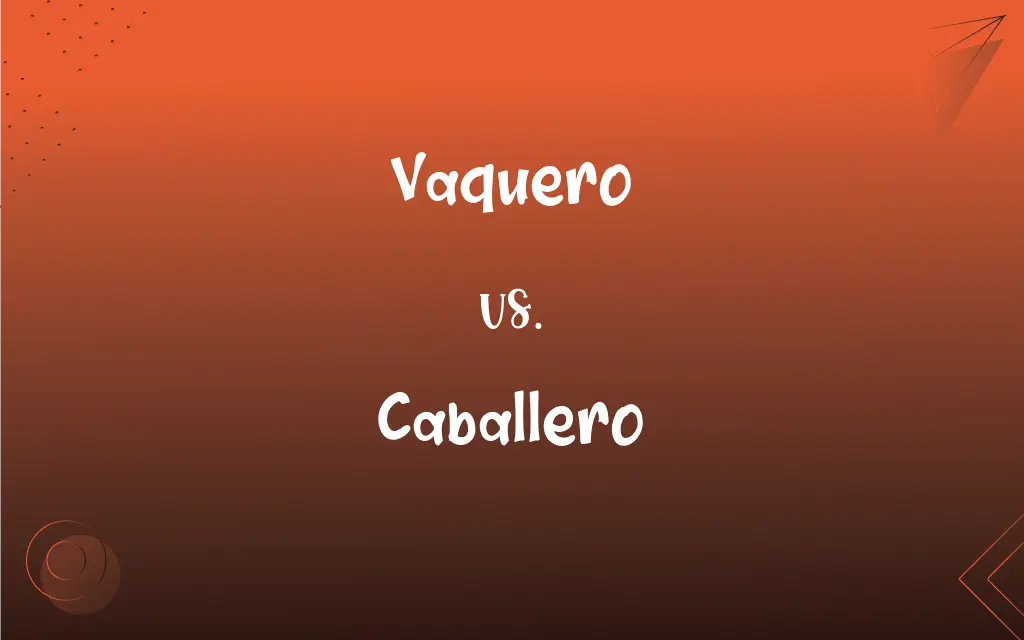Vaquero vs. Caballero: What's the Difference?
Edited by Janet White || By Harlon Moss || Updated on November 7, 2023
A vaquero is a cowboy, particularly in Spanish-speaking regions, while a caballero is a gentleman or a knight in Spanish culture.

Key Differences
A vaquero is traditionally a horse-mounted livestock herder, equivalent to a cowboy, with a heritage rooted in Spain and carried on in Mexico and the southwestern United States. They are skilled in handling cattle and proficient in riding horses. The term caballero, on the other hand, carries a different connotation; it refers to a gentleman or a knight and is associated with chivalry, courtesy, and a certain nobility of behavior.
The word vaquero is specific in its association with cattle ranching and the open range. Vaqueros are known for their distinctive attire, which often includes a wide-brimmed hat and spurs, adapted for the practicalities of ranch work. Caballero, conversely, denotes a man of high social standing or manners and is not necessarily linked to a particular profession or attire.
When discussing vaqueros, one often thinks of rugged individuals who spend much of their time outdoors, engaging in physical work that requires a deep knowledge of animal husbandry. Caballeros, in the context of historical Spain or Latin American society, might be thought of as well-educated and well-mannered men, often from the upper classes, who might ride horses for sport or leisure rather than work.
The cultural heritage of vaqueros is significant in the development of rodeos and certain styles of horse riding and cattle herding, heavily influencing the North American cowboy. The cultural image of a caballero is more aligned with the European concept of knighthood or the ideal of a refined gentleman who upholds high standards of conduct.
In modern usage, vaquero still refers to someone who works with cattle on horseback, and it is imbued with the rich traditions of the American West. Caballero, while it can still imply nobility or gentlemanliness, is also used colloquially in Spanish to address men in a respectful manner, somewhat equivalent to "sir" in English.
ADVERTISEMENT
Comparison Chart
Definition
Cowboy, livestock herder.
Gentleman, knight.
Cultural Origin
Spanish, used in the Americas.
Spanish, European origins.
Professional Context
Cattle ranching, horseback riding.
Social status, not job-specific.
Attire
Practical ranch wear, hat, boots, spurs.
Implies refined dress, possibly historical armor.
Modern Connotation
Rugged, outdoors work.
Chivalry, respectfulness, politeness.
ADVERTISEMENT
Vaquero and Caballero Definitions
Vaquero
A cowboy or cattle herder.
The vaquero roped the stray calf with precision.
Caballero
A man who exhibits qualities of chivalry.
The caballero’s actions at the formal event were commendable.
Vaquero
A herdsman in the Spanish-speaking regions of the Americas.
The vaquero’s silhouette against the setting sun was iconic.
Caballero
A knight or man of honor in Spanish-speaking countries.
In the tale, the caballero saved the village from the dragon.
Vaquero
A livestock handler in traditional Spanish culture.
The vaquero’s knowledge of the land was unparalleled.
Caballero
A courteous and well-mannered man.
He offered his seat to the elderly woman, acting like a true caballero.
Vaquero
A horseman skilled in managing cattle.
He worked as a vaquero on the vast Argentinian pampas.
Caballero
A Spanish gentleman; a cavalier.
Vaquero
An individual who performs rodeo skills originating from Spain.
The vaquero amazed the crowd with his horsemanship at the rodeo.
Caballero
A man who is skilled in riding and managing horses; a horseman.
Vaquero
See cowboy.
Caballero
A horseman, particularly in the Latin American context
Vaquero
(Southwestern US) A cowboy; a herdsman.
Caballero
A Spanish gentleman.
Vaquero
One who has charge of cattle, horses, etc.; a herdsman; a cowboy.
Caballero
A Spanish line dance.
Vaquero
Local names for a cowboy (`vaquero' is used especially in southwestern and central Texas and `buckaroo' is used especially in California)
Caballero
A knight or cavalier; hence, a gentleman.
Caballero
A term of respect for a man in contemporary Spanish.
Buenos días, caballero, the waiter greeted the man entering the café.
FAQs
Can vaquero be used in English?
Yes, it's used in English to describe a Spanish cowboy.
Are vaqueros part of American history?
Yes, they are integral to the history of the American West.
What does a vaquero do?
A vaquero herds cattle on horseback.
How is caballero used in contemporary society?
Often as a sign of respect towards a man.
What skills must a vaquero have?
Skills in horseback riding and cattle herding.
Does caballero have an English equivalent?
Yes, the closest equivalents are "gentleman" or "sir."
Are there vaquero competitions?
Yes, rodeos often have events based on vaquero skills.
What is a caballero?
A caballero is a gentleman or knight in Spanish culture.
Do vaqueros still exist?
Yes, particularly in regions like Texas and Mexico.
Is caballero used in modern Spanish?
Yes, as a polite form of address for men.
What attire does a vaquero wear?
Traditionally, a wide-brimmed hat, boots, and sometimes spurs.
Is vaquero gender-specific?
Traditionally, yes, but the term can refer to any gender today.
Can anyone be called a caballero?
In modern speech, any man can be called a caballero as a sign of respect.
Can caballero refer to an actual knight today?
It's rare, more often it's used metaphorically.
What does it mean to call someone caballero?
It means you're calling them a gentleman or sir.
Can vaquero refer to a style of clothing?
Yes, it can also describe the traditional clothing worn by cowboys.
Is being a caballero tied to social status?
Historically, yes, but not necessarily in modern use.
Are caballeros part of chivalric orders?
Historically, yes; they could be knights in such orders.
What is the female equivalent of vaquero?
Vaquera is the female counterpart.
Do caballeros have to ride horses?
Not in modern usage, it's more about behavior than riding.
About Author
Written by
Harlon MossHarlon is a seasoned quality moderator and accomplished content writer for Difference Wiki. An alumnus of the prestigious University of California, he earned his degree in Computer Science. Leveraging his academic background, Harlon brings a meticulous and informed perspective to his work, ensuring content accuracy and excellence.
Edited by
Janet WhiteJanet White has been an esteemed writer and blogger for Difference Wiki. Holding a Master's degree in Science and Medical Journalism from the prestigious Boston University, she has consistently demonstrated her expertise and passion for her field. When she's not immersed in her work, Janet relishes her time exercising, delving into a good book, and cherishing moments with friends and family.
































































